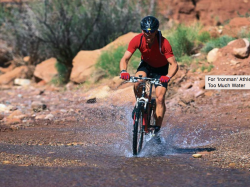Hyponatremia is a medical term describing low (hypo) blood sodium levels (natremia – Na is the chemical symbol for sodium).
There are a few different causes of the condition, but the one of interest to athletes is when dilution of sodium levels in the blood is driven by excessive drinking. This can be made worse by the loss of sodium in sweat during prolonged exercise.
Data on the prevalence of the condition in Ironman finishers suggests, scarily, that over 10% of athletes have hyponatremia at the end of a race!
Why is hyponatremia bad?
Maintaining blood sodium levels within a healthy range is critical to homeostasis and optimal bodily function. When blood sodium levels drop below this ideal range, initial symptoms can include...
- Nausea
- Lethargy
- Muscle cramps
- Weakness/fatigue
- Headaches
- Restlessness
Because of how finely balanced your blood sodium levels need to be for good health, even mild hyponatremia during exercise is bad news. It can seriously undermine your performance well before it starts to make you properly ill (or, in rare and extreme cases, even kill you)
How can you avoid hyponatremia?
In theory, avoiding hyponatremia is pretty straightforward, you just have to avoid drinking more that you sweat and pee out, so that dilution of your blood does not occur.
For quite a while some experts (notably Prof Tim Noakes, with many others following his lead) have been advocating a ‘drink water to thirst’ approach for this very reason. But this approach leaves athletes to train for and compete in any event, of any length or intensity, and in all conditions, with nothing more than this relatively vague advice to guide their hydration strategy.
It also ignores the valuable contribution of supplementing fluid intake with additional sodium to help aid fluid retention, maintain blood sodium levels and replace some of that lost in sweat. At a certain point the usefulness of ‘drink to thirst’ guidelines effectively ends. And that point is probably when you’re exercising for more than 2 hours, assuming you began well hydrated.
If avoiding hyponatremia is your one and only objective, then drinking to thirst is probably ok advice to follow. But, in my view, it starts to get more complicated when you consider that most athletes want to perform at their best, not just ‘survive’ a race.
Simply drinking water ‘to thirst’ on these occasions is not always adequate to maintain blood plasma volumes to a degree that’s compatible with peak performance. It’s a lot more productive to think of dehydration as existing on the opposite end of the scale to hyponatremia, and to aim to strike a balance between these two extremes.
It’s long been known that taking sodium in with drinks increases fluid retention in the blood stream. Also, sweat contains a relatively large (and variable) amount of sodium in it so, when sweat output is high, the net loss of sodium can be substantial too.
Sodium is a finite resource in the body and, as a result, supplementation can help to maintain both blood volume and blood sodium levels much better than drinking water alone, especially at times when sweat losses are high. It also helps reduce the rate of dilution in the bloodstream when compared to just taking in water alone.
Personalising your sodium and fluid intake not only reduces the risk of hyponatremia, but maximise your performance when sweat losses are high. Personalisation is best achieved through a combination of data collection (taking a Sweat Test) and some good ol' fashioned trial and error in training and events.
With our new Sweat Test, we’ll fully personalize your hydration strategy, giving you the knowledge and tools you need to stay hydrated so you can avoid hyponatremia and perform at your best.

